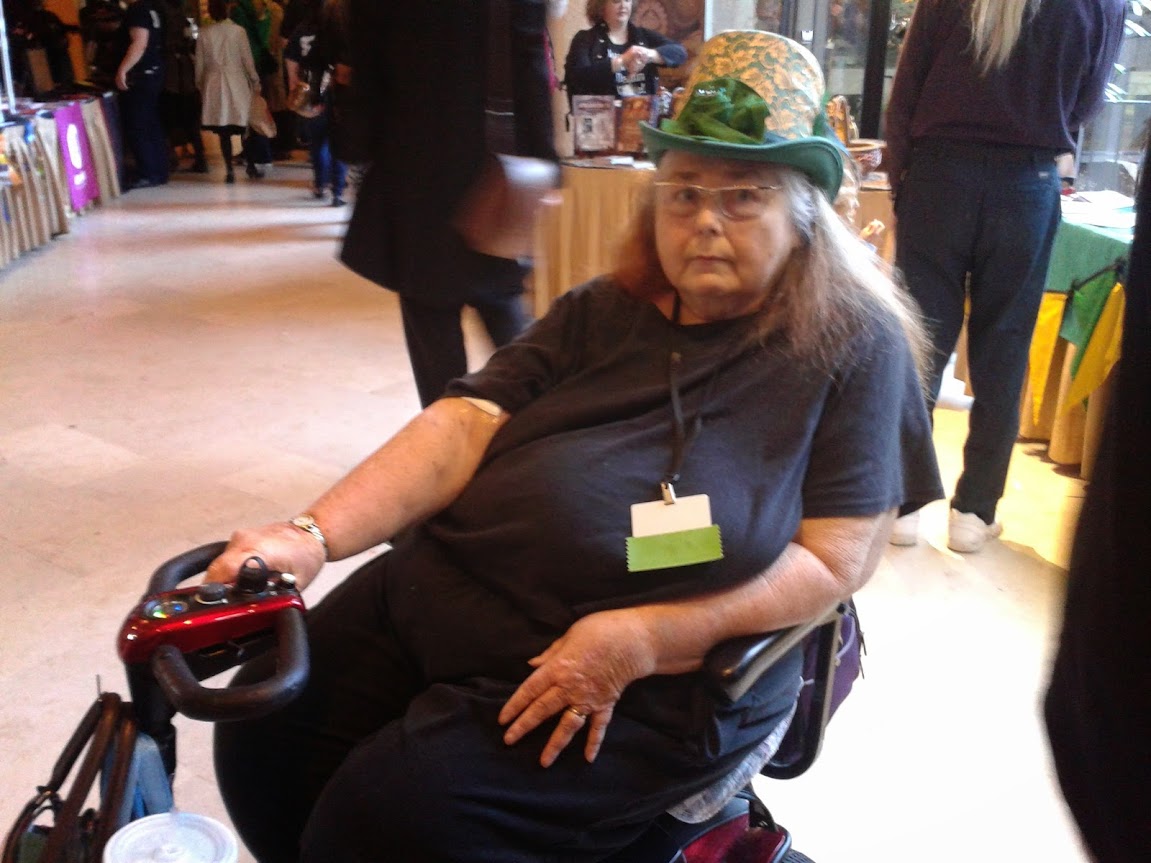Naomi wrote about her experiences with using wheelchairs and scooters. Let me (Steve) tell you about my experiences going st/rolling with Colleen.
What’s a st/roll?
The day after Colleen’s mobility scooter arrived, we went for our first st/roll. I strolled, she rolled. It was wonderful — for the first time in over a decade, I had trouble keeping up with her!
It took a little getting used to, of course. Colleen learned the hard way that she had to slow down on turns, and make sure to go straight up and down ramps and curb cuts instead of cutting across diagonally. In fact, she fell on her first day out, going diagonally down a curb cut half a block from our house. That’s why our first real st/roll was the next day. After a brief ER visit.
Lowering the center of gravity by shortening the seat post helped, as did getting a slightly wider scooter a few years later, but she still had a few more spills and close calls. None of that fazed her — she was one of the three toughest women I’ve ever met (my mom and Naomi are the others).
Our usual st/roll took us from our house in San Jose, across West San Carlos Avenue, around the Municipal Rose Garden, and back — about 3/4 mile for the round trip. Sometimes we’d circle the Rose Garden twice, or spend some time inside looking at the roses. (The Rose Garden isn’t worth a trip to San Jose all by itself unless you’re a fanatical rose fancier, but it’s well worth going a few miles out of your way for if you happen to be in the area; you can get there from downtown by bus.)
Making space
Let’s face it — a scooter is a big, clumsy thing to have around the house. When Colleen was able to use a walker in the house, or a power chair, the scooter mostly stayed in whatever vehicle we were using. Somewhat surprisingly, it takes less space than a wheelchair, even one with detachable wheels. It fits comfortably in a Honda Civic or a Chevrolet Bolt.

There’s still some room for luggage.
Having a scooter in the house also requires a ramp. I improvised our first ramp out of a sheet of plywood and some 2x4s; after a year or so we hired a contractor to replace it with concrete, and never regretted it.
Buying a scooter
The first time we used a scooter we borrowed one from a friend and went to a local science fiction convention. Getting a scooter weighing well over a hundred pounds in and out of a mini-van proved to be a challenge, but I managed it, and Colleen had a great time at the convention. It convinced me of two things: 1. We really wanted a scooter, and 2. It had to be easy to take apart for travel. What we decided on was a Pride Go-Go Elite Traveller Portable Scooter.

Like most travel scooters, the Pride Go-Go scooters come apart in five pieces: the rear end with the motor and rear wheels, the front section with the tiller and the deck, the battery box, the seat, and the basket. That’s from heaviest to lightest, although the front section may be the heaviest on some of the four-wheeled versions. (It’s also not counting the charger, but make sure you don’t leave it behind when you’re traveling!) The heaviest piece is somewhere between 25 and 35 pounds. Some things to consider when you go scooter shopping:

- The larger battery is heavier, but it gives you more range and, perhaps more importantly, lowers the scooter’s center of gravity, making it harder to tip over.
- A three-wheeled scooter has a shorter turning radius — barely more than the scooter’s length. That’s a huge advantage in tight places like bathrooms and elevators.
- The down side of having a short turning radius is that you have to remember to slow down before you turn, or you risk falling.
- The larger scooters have larger wheels and more ground clearance. It’s easy to get hung up on a door threshold or the top of a ramp. They also perform better on rough surfaces, and the larger wheels make it easier to get over bumps.
- After the first few trips we wound up leaving the basket behind; Colleen discovered that the bracket was a great place to hang a tote bag or large purse.
- The Pride scooters all have a pocket behind the seat back where you can stash the charger. (Other brands may have different arrangements.)
- If you have a dufflebag or gym bag with a shoulder strap, you can shorten the strap and hang it from the seat back. We kept it under the bed, packed and ready to go.
- Don’t worry about losing the key — all Pride scooters use the same one. Buy a few extra.
By the way, I’ve been concentrating on Pride scooters because those are the ones I’m most familiar with. After buying our first one, we stuck with the brand because all of the Go-Go scooters we looked at use the same interchangeable battery packs. There are two sizes: 12 and 18 amp-hours. Don’t expect the batteries to last more than two or three years. Replacing them is easy — all it takes is a Phillips screwdriver with a long shank.
The essential accessory
One of the best purchases we made — aside from the scooter itself, of course — was a scooter cape. A scooter cape is cut so that it’s short in back and longer in front. That means that when you’re sitting on the scooter, you can put the front of the cape over the tiller. Some of the capes you can find have a clear vinyl panel in front; those would work well if your scooter has a headlamp or you want to be able to see the controls.

The one we got for Colleen is waterproof on the outside, and lined with fake fleece (Sherpa or something like it); it not only kept her warm and dry in bad weather, but she could use it as a blanket. Colleen always felt cold in hospitals — the cape was an essential part of her going-to-the-hospital kit, and kept her warm and cozy through many a lonely night in bed. I use it now. The memories are as warm as the cape.


Leave a Reply